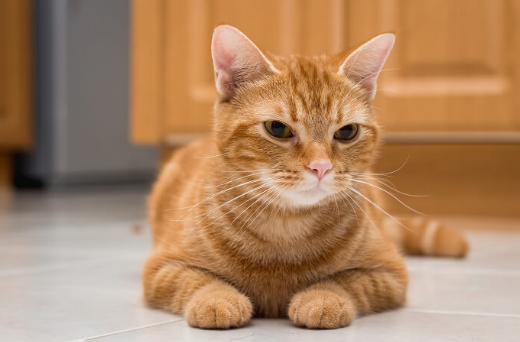Beyond its beautiful, curly coat lies the LaPerm cat’s absolutely charming personality. A single encounter with this sweet feline is likely to capture your heart.
LaPerm cats excel as family pets, endearing themselves to individuals of all ages, from young children to grandparents. They effortlessly form connections with other pets, be they companion cats or well-mannered dogs. Cuddling is one of their favorite pastimes, and they can be found comfortably settling on laps, beside you, or even under covers.
In the midst of their nap sessions, these fabulous cats remain engaged in various activities. Their love for assisting with human projects matches their enthusiasm for playing with toys. Possessing a naturally curious nature, LaPerm cats may delight in exploring unsecured cupboards and drawers, inspecting and occasionally rearranging their contents.
For those seeking a more tranquil pet, the LaPerm cat may be an ideal choice. When vocalizing, their voice is soft and sweet, avoiding harsh demands. A gentle tap with their paws is a common method of seeking attention.
These lovable cats are quick to make friends with anyone they encounter. With proper socialization during kittenhood, a LaPerm cat is likely to extend a warm welcome to both new acquaintances and familiar friends as they mature.
- Origin: United States
- Weight: Between 6 and 10 pounds
- Length: Between 12 and 18 inches
- Size: Medium, with males weighing from 7 to 10 pounds and females weighing from 5 to 8 pounds
- Color: White, black, blue, red, cream, chocolate, cinnamon, fawn, and lavender, plus various patterns and shadings
LaPerm cat Breed Characteristics
This cat, adorned with a distinctive curly coat, embodies traits of friendliness, affection, and curiosity. Its unique appearance stems from a spontaneous genetic mutation. The coat, exhibiting varying lengths, showcases a broad spectrum of colors and patterns typical of cats. While some kittens are initially born with bald or straight coats, the majority acquire their curly coats as they reach maturity.
The LaPerm’s visual appeal might suggest an accidental encounter with a static charge, yet its curly coat is a result of a natural genetic mutation, not uncommon in the feline world. Initially born bald or with short hair, these cats develop a wavy or ringlet coat as they mature.
Their coats manifest in a diverse array of colors and patterns, with tortoiseshell, tabby, or red being the most common. Whether short or long, the coat extends over the entire body, encompassing the distinctive curly tail. However, not all LaPerms undergo the development of a curly coat.
Some cats are born with straight coats and maintain this feature throughout their lives. If you seek assurance that your LaPerm will exhibit curls, consider selecting one whose mature coat has already manifested.
size And weight
A medium-sized feline, the LaPerm typically weighs between 5 to 10 pounds and attains maturity at two to three years of age.
Possessing the characteristic traits of a cat, the LaPerm exhibits an inquisitive nature, a penchant for heights, and an eagerness to engage in whatever activities its human companions are involved in. Whether perched on a shoulder or atop a cat tree, this feline enjoys keeping a watchful eye on its surroundings.
Don’t be surprised if the LaPerm gently pats your face to draw attention or open things up. While inherently active, it readily seizes opportunities to rest on your lap and indulge in a satisfying meal.
A well-socialized LaPerm, especially during kittenhood, is inclined to be sociable with guests. It proves to be an excellent choice for families with older children who treat it respectfully, although supervision is advisable around toddlers to prevent them from pulling on the cat’s curls. Additionally, the LaPerm can coexist harmoniously with cat-friendly dogs.
Maintaining its coat is a straightforward task, as it typically sheds minimally. Periodic heavy sheds may occur, resulting in a thicker coat afterward. Apart from grooming the coat, the LaPerm requires routine nail trimming and ear cleaning to ensure overall well-being.
hypoallergenic
The notion that the LaPerm coat is hypoallergenic due to its curly nature is not accurate. Allergies are not influenced by a specific coat type but rather by dander—dead skin cells that all cats (and humans) naturally shed.
Scientific evidence does not support the idea that any particular cat breed or crossbreed is inherently more or less allergenic than another. While some individuals with allergies may have milder reactions to certain cats, reputable breeders do not provide guarantees of hypoallergenic qualities in their cats.
The LaPerm cat can thrive in any home where it receives love and regular grooming for its distinctive coat. Keeping the LaPerm indoors is advisable to protect it from potential hazards such as traffic, diseases transmitted by other cats, and potential attacks from other animals.
| Adaptability: 5Point | Health Issues: 1Point |
| Energy Level: 4Point | Stranger Friendly: 4Point |
| Child Friendly: 4Point | Affectionate: 5Point |
| Social Needs: 4Point | Dog Friendly: 5Point |
| Shedding Level: 3Point | Intelligence: 5Point |
| Grooming: 1Point |

History
Upon first glance, the LaPerm appears as though it has just emerged from a professional grooming session. However, this breed’s distinctive style is crafted solely by Mother Nature. Also known as Dales LaPerm, this cat is a relatively recent addition to accepted breeds, emerging in the 1980s.
The LaPerm’s origin story unfolds in a cherry orchard in The Dalles, Oregon. In early March 1982, a common brown tabby barn cat named Speedy gave birth to six kittens.
Owners Linda and Richard Kohl noticed a striking difference in one of the kittens. This particular feline, instead of sporting the fur typical of its siblings, was entirely bald. Moreover, it was smaller in size, possessed large ears, and had an elongated body.
Around eight weeks old, soft curly hair began to sprout, eventually developing into a gentle, wavy coat. Appropriately named Curly by Linda Kohl, this cat matured into an inviting presence, showcasing not only a unique coat but also a sweet, gentle, and trusting personality.
Curly, in turn, became the catalyst for Linda Kohl’s newfound passion for cats, transforming her from someone who had previously owned cats for their effective pest control into a genuine cat enthusiast.
Curly went on to have her own litter of five male tabby kittens, all born without fur. Similar to their mother, they soon developed curly hair coats. Over the next decade, Linda Kohl allowed the breeding to occur naturally, without intervention or monitoring of the curly lineage.
The distinctive curly coat is governed by a dominant gene, meaning that only one parent needs to possess the gene to produce curly-coated offspring. Due to this genetic trait and the relatively small gene pool, the population of curly-coated cats experienced rapid growth over the following decade.
CFA Show
In 1992, a decade after Curly’s birth, Linda Kohl showcased four of her curly-haired cats at the CFA Show in Portland, Oregon, seeking the opinions of professional exhibitors and judges. To enter the show, a breed name was required, leading Kohl to christen Mother Nature’s creation “Leperm” due to the coat’s resemblance to a permanent wave.
The unexpected and warm reception her cats received surprised Kohl. The judges, recognizing the unfamiliarity of the breed within the feline community, advised her to preserve it. With the assistance of others, Kohl initiated an enrichment program and embarked on the extensive process of obtaining accreditation for LaPerm.
Currently, the three largest cat associations in North America—ACFA, CFA, and TICA—acknowledge and accept LaPerm for championship status.
Appearance
In terms of size and physique, the LaPerm is a medium-sized cat characterized by a moderately athletic build and elongated legs proportional to its size. However, what truly distinguishes this breed is its unique coat, which is characterized by waves and curls.
Remarkably, it’s not uncommon for LaPerm kittens to be born without any fur. Some kittens may have short hair at birth, which is shed in the initial weeks, typically starting from the top of the head. Over the subsequent months, the kitten regrows its coat, and even those born bald usually develop a curly coat by the time they reach several months of age.
LaPerm’s fur exhibits its curliest texture along the cat’s belly, around the neck, and at the base of the ears. Short-haired LaPerms generally display more waves, while their long-haired counterparts may boast tight ringlets and curls. Long-haired LaPerms often feature a substantial, curly neck and a tail that is voluminous, fluffy, and plumed.
Both long-haired and short-haired LaPerms typically have coats that stand slightly off their bodies, creating a fluffy and airy appearance. The hair itself is soft, springy, and tends not to shed excessively, although LaPerms are not generally classified as hypoallergenic cats.
Regarding coloration, LaPerm cats exhibit a broad spectrum, encompassing any genetically possible color or pattern for cats. This includes solid, bi-color, tabby, calico, “tuxedo,” tortoiseshell, or even colored “dots” on the ears, face, and tail—a characteristic reminiscent of the Siamese cat.
Similar to their diverse coat colors, LaPerms can have eyes of any shade commonly found in cats, such as amber, green, brown, copper, blue, or even two different-colored eyes.
Temperament
The affectionate and gentle LaPerm is undeniably a lap cat that thrives on human attention. This breed actively seeks opportunities to join you for a nap on the couch, often expressing their contentment with loud coos. According to the Cat Fanciers Association, these loving kittens frequently extend their paws to touch your face and nuzzle their heads against you as gestures of affection.
“Laperms are typically people-oriented cats—they relish being with their humans,” states Carol Evans, Secretary of the LaPerm Cat Club. “They appreciate physical contact, although some may be less inclined, which is rare. They display curiosity, enjoy being active, and are calm and quiet, tending to approach visitors rather than shy away.”
In moments when they are not vying for your attention, the energetic LaPerm indulges in play. Possessing remarkable intelligence, these curious cats are known to enjoy fetching toys. They easily get along with various playmates, including children, other cats, and cat-friendly dogs.
“‘Aloof’ is not a term fitting for LaPerms,” emphasizes Evans. “They are people-loving, in-your-face companions. They follow you around the house and are always in close proximity.”
Personality
LaPerms are gentle, people-oriented felines that display affection without being excessively demanding or clingy. They cherish human companionship and readily adapt to indoor living or apartment life, provided they receive the requisite play and pampering.
Similar to most cats, LaPerms form close bonds with their human friends through regular interaction and affection. With agility and activity reminiscent of their barn cat ancestors, they revel in engaging games of chase and relish pouncing on catnip mice.
Their preference for interactive toys, where you actively participate, is evident. Fueled by curiosity, they eagerly involve themselves in all household activities. Unlike some high-energy breeds, LaPerms find contentment in sitting on your lap for quality petting and pampering after a playful session.
LaPerms typically maintain a quiet demeanor, vocalizing only when they have something deemed exceptionally important, such as drawing attention to empty food dishes. Nonetheless, they enjoy the occasional subdued conversation with their favored humans, particularly relishing it when their human companions take the lead in the exchange.
Health
Like all cats, LaPerms may potentially develop genetic health issues, akin to hereditary diseases in humans. Be cautious of breeders who do not offer health guarantees on kittens or claim their kittens are isolated from the main household for health reasons.
As of now, LaPerms are not known to have specific genetic diseases. Nonetheless, it is prudent to purchase from a breeder who provides a documented health guarantee.
Upon welcoming a new kitten into your home, you hold the key to safeguarding them from prevalent health concerns, with obesity being one of them. Maintaining the LaPerm at an optimal weight is a straightforward method to promote their overall health.

Care
Despite their curly (and occasionally long) fur, LaPerm cats boast a smooth coat, as noted by Evans. Long-haired LaPerms necessitate weekly combing to prevent mats and tangles, while their short-haired counterparts require no brushing. Occasional baths contribute to maintaining the beauty of your kitty’s curls.
Like all cats, LaPerms require regular ear checks and cleaning, nail trimming, and upkeep of their litter box. Given their high activity level, LaPerms are naturally inclined to movement, making it easy to motivate them. However, owners should still encourage exercise and play, as LaPerms enjoy following their human lead. Interactive cat games, especially during kittenhood, are favored by this breed for expending energy.
“When bringing home a new kitten, it’s crucial to understand that a bored LaPerm is a mischievous LaPerm,” advises Evans. Kittens thrive on play, exploration, and boundless energy, so be prepared to provide toys, games, and ample time. The effort invested yields significant rewards.
Due to their intelligence, LaPerms are typically mentally stimulating to train and easy to love. Basic tasks like using the litter box or scratching a post can be trained, and once these fundamentals are mastered, they are eager to learn more advanced tricks.
Socialization comes naturally to this easy-going breed. LaPerm cats are introduced early to people and other pets tend to be welcoming and receptive to unfamiliar faces.
Feeding LaPerms high-quality cat food recommended by a veterinarian is essential. Despite their high activity levels, monitoring your cat’s food intake is crucial to prevent obesity.
Best Food For
- Hill’s Prescription Diet y/d with Chicken Wet Cat Food
- Hill’s Prescription Diet y/d Chicken Flavor Dry Cat Food
- Hill’s Science Diet Adult Chicken Recipe Cat Food
- Hill’s Science Diet Adult Ocean Fish Entrée Cat Food
Feeding
Consider the recent ancestry of LaPerms, which includes formidable cats like leopards, lions, and tigers, when determining their diet. In nature, adult tigers, for instance, don’t consume apples, chew grass, or drink milk, as seen on Animal Planet. Similarly, young jaguar cubs don’t seek milk from cows or other animals in the wild. While these examples may seem extreme, they emphasize that LaPerms, with their shared ancestry, may exhibit specific dietary preferences.
LaPerms don’t adhere to the same eating habits as humans or dogs. Their nutrition preferences are relatively consistent, primarily revolving around a diet rich in meat for essential protein and fat. Unlike humans, who would face health issues with such a diet, LaPerms thrive on this protein-centric approach.
It’s crucial to recognize that treating LaPerms like family members doesn’t entail feeding them identical diets as humans or dogs. Feeding LaPerms a diverse range of foods may lead to unexpected consequences, such as a hunger strike.
It’s not uncommon for people to feed their LaPerms in a manner similar to their dogs, which can be problematic. Dog food, for instance, can pose risks to LaPerms over time due to its mismatch with their dietary needs, often containing excessive carbohydrates that LaPerms struggle to process efficiently.
Overfeeding LaPerms with diets high in carbohydrates is linked to obesity and an increased risk of diabetes. In essence, LaPerms should avoid carbohydrate-rich diets to maintain optimal health.
Grooming
Maintaining a LaPerm’s coat is a straightforward task. To prevent or eliminate mats and tangles, a weekly combing session is sufficient. While LaPerms typically don’t shed excessively, there might be occasional heavy shedding, resulting in a thicker coat afterward.
Some LaPerms may experience a “molt” phase, leading to a sparser coat that may not fully regrow. However, hormonal changes post-spay/neuter surgery often contribute to the restoration of a lush and full coat.
Additional grooming for LaPerms involves regular nail clipping and ear cleaning if the ears show signs of dirt. Utilize a mild cleanser recommended by a veterinarian. To ensure good overall health and fresh breath, frequent brushing of teeth with vet-approved pet toothpaste is advisable.
Commence the grooming routine, including brushing, nail clipping, and ear cleaning, while the LaPerm is still a kitten, fostering a positive association with these activities for later stages.
Training
Train your LaPerm cat to respond to various commands, such as shaking paws, rolling over, and sitting. Avoid overwhelming your pet by introducing new tricks gradually; patience and consistency are key.
When teaching tricks, focus on one at a time to prevent confusion. Additionally, gradually expose your LaPerm kitten to other pets, including cats and dogs, in controlled and supervised environments.
Exercise
LaPerm cats possess a natural inclination for activity. Apart from engaging in running and jumping, they exhibit an above-average fondness for climbing. If you decide to welcome one of these delightful cats into your home, it’s advisable to provide multiple cat trees and contemplate installing cat-friendly shelves on the walls.
LaPerms have a preference for observing their surroundings from elevated vantage points, and without these accommodations, they might resort to less convenient perches like closets or the top of the refrigerator.
Similar to many other cat breeds, LaPerms tend to gradually decrease their activity levels as they age. Reduced activity can potentially lead to weight gain, so it’s essential to keep them occupied by offering puzzle toys, feather sticks, catnip mice, and other favored items.
Adoption Center
Given the rarity of LaPerms, locating them in rescue or shelter settings is unlikely. In some cases, finding LaPerm breeders in your local area might prove challenging. However, attending a cat show, particularly in a larger city, can increase your chances of encountering a reputable breeder.
Another avenue is exploring breeder listings on major cat association websites, such as The International Cat Association.
See More Cat Breeds For Further Research
FAQs
LaPerm Cat Price
LaPerm Breeders – There are very few breeders in North America for LaPerms, and the cost of LaPerm kittens typically ranges from approximately $900 to $1500. Prices vary based on factors such as gender, color, coat length, and whether the kittens will be shown, bred, or kept as pets.
Are LaPerm cats cuddly?
LaPerm cats are characterized by their charming and curly-haired appearance, coupled with gentle and affectionate personalities. The wavy coat, resulting from a mutated gene discovered in the 1980s, defines this relatively new breed. Their affectionate nature and propensity for being lap cats, along with a low-maintenance coat, make them delightful and cuddly companions.
How can you tell if a cat is a LaPerm?
LaPerms are medium-boned with a muscular build and possess distinctively curly coats that range from waves to ringlet curls to corkscrew curls. The tightest curls are typically found on the lower part of the cat, around the base of the neck and ears. LaPerms can have either short or long coats.
What’s the rarest cat breed?
The Sokoke cat holds the title of the rarest domestic cat breed globally, according to the UK’s Governing Council of the Cat Fancy (GCCF).











